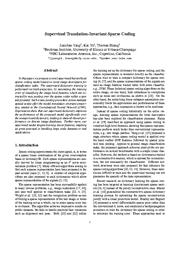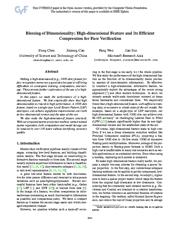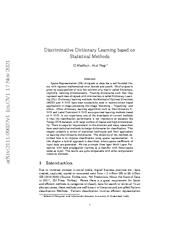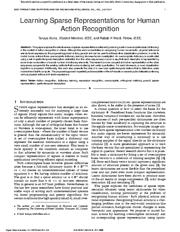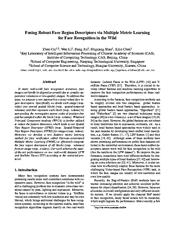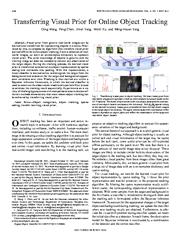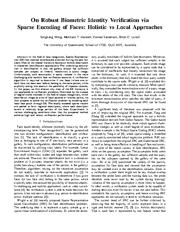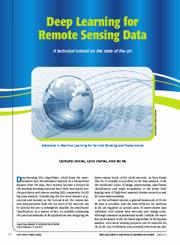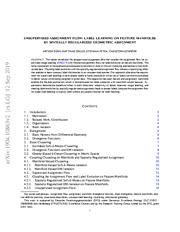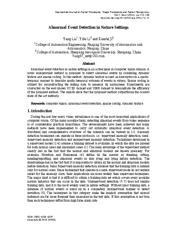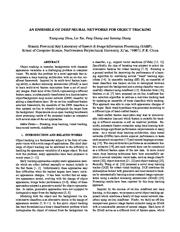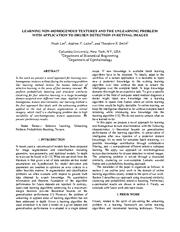The Internet Archive has a preservation copy of this work in our general collections.
The file type is application/pdf.
Filters
Large Scale Strongly Supervised Ensemble Metric Learning, with Applications to Face Verification and Retrieval
[article]
2012
arXiv
pre-print
Its applications to face verification and retrieval outperform existing state-of-the-art methods in accuracy while retaining high efficiency. ...
This paper addresses both aspects by an ensemble metric learning approach that consists of sparse block diagonal metric ensembling and join- t metric learning as two consecutive steps. ...
unsupervised metric learning method. ...
arXiv:1212.6094v1
fatcat:2tzhrsdzfjdgbn3tpt2grjp3f4
Supervised translation-invariant sparse coding
2010
2010 IEEE Computer Society Conference on Computer Vision and Pattern Recognition
Experiments show that our supervised dictionary improves the performance of the proposed model significantly over the unsupervised dictionary, leading to state-of-the-art performance on diverse image databases ...
In this paper, we propose a novel supervised hierarchical sparse coding model based on local image descriptors for classification tasks. ...
Acknowledgement The main part of this work was done when the first author was a summer intern at NEC Laboratories America in Cupertino, CA. The work is also supported in part by the U.S. ...
doi:10.1109/cvpr.2010.5539958
dblp:conf/cvpr/YangYH10
fatcat:36d2xms3ibcdtiituf6zdonmq4
Blessing of Dimensionality: High-Dimensional Feature and Its Efficient Compression for Face Verification
2013
2013 IEEE Conference on Computer Vision and Pattern Recognition
A 100K-dim feature, based on a single-type Local Binary Pattern (LBP) descriptor, can achieve significant improvements over both its low-dimensional version and the state-of-the-art. ...
This prevents further exploration of the use of a highdimensional feature. In this paper, we study the performance of a highdimensional feature. ...
High-dimensional feature with unsupervised learning In this experiment, we study the impact of high dimensionality under the unsupervised setting. ...
doi:10.1109/cvpr.2013.389
dblp:conf/cvpr/ChenCWS13
fatcat:4u4lnjypo5h5xfoxgcprlbqyjq
Discriminative Dictionary Learning based on Statistical Methods
[article]
2021
arXiv
pre-print
Training dictionaries such that they represent each class of signals with minimal loss is called Dictionary Learning (DL). ...
This chapter presents a review of statistical techniques and their application to learning discriminative dictionaries. ...
In [43] , group sparse coding with HoG feature descriptors is used to achieve good results on face recognition. ...
arXiv:2111.09027v1
fatcat:zzdz2m3rvfauxjw4eu2mgpk5mu
Learning Sparse Representations for Human Action Recognition
2012
IEEE Transactions on Pattern Analysis and Machine Intelligence
This paper explores the effectiveness of sparse representations obtained by learning a set of overcomplete basis (dictionary) in the context of action recognition in videos. ...
An overcomplete dictionary is constructed using a set of spatio-temporal descriptors (extracted from the video sequences) in such a way that each descriptor is represented by some linear combination of ...
THE PROPOSED APPROACH Our approach broadly consists of four stages : computation of the spatio-temporal motion descriptors, di-mensionality reduction of the descriptors, learning overcomplete dictionaries ...
doi:10.1109/tpami.2011.253
pmid:22745001
fatcat:6ime7uvamfgq3jg5dz4nrj7cya
Fusing Robust Face Region Descriptors via Multiple Metric Learning for Face Recognition in the Wild
2013
2013 IEEE Conference on Computer Vision and Pattern Recognition
Moreover, we develop a new distance metric learning method for face verification called Pairwise-constrained Multiple Metric Learning (PMML) to effectively integrate the face region descriptors of all ...
Spatial-Temporal Face Region Descriptor, STFRD) for images (resp. videos). ...
Face Region Descriptor and PMML Our approach consists of two key components: face region descriptors and the learning algorithm PMML. ...
doi:10.1109/cvpr.2013.456
dblp:conf/cvpr/CuiLXSC13
fatcat:iyikihhqmvfz3jgfejsbmg26km
Transferring Visual Prior for Online Object Tracking
2012
IEEE Transactions on Image Processing
From a collection of realworld images, we learn an overcomplete dictionary to represent visual prior. ...
The prior knowledge of objects is generic, and the training image set does not necessarily contain any observation of the target object. ...
Wang was a visiting student at the University of California at Merced. ...
doi:10.1109/tip.2012.2190085
pmid:22491081
fatcat:obwthxkxqvag5eo6rwtqsaqpp4
On robust biometric identity verification via sparse encoding of faces: Holistic vs local approaches
2012
The 2012 International Joint Conference on Neural Networks (IJCNN)
The locally encoded sparse vectors are pooled to form regional descriptors, where each descriptor covers a relatively large portion of the face. ...
Most of the related literature focuses on holistic descriptors in closed-set identification applications. ...
Each sparse encoding approach learns a dictionary (or model), D ∈ R d×N , using an unsupervised learning algorithm, where each column d i ∈ R d of the dictionary is an atom. ...
doi:10.1109/ijcnn.2012.6252611
dblp:conf/ijcnn/WongHSL12
fatcat:6xuf7p62zfgkpj3ophe3xuoe5e
Problem Definition on Face Recognition: A Review
2019
Asian Journal Of Advanced Basic Sciences
During this work, multiscale DoG is first performed to come up with overcomplete face illustration, and then three native descriptors specifically HOG, GLOH and SIFT area unit applied to construct the ...
In this work, we have a tendency to explore the basis of the principle of some popular existing descriptors for VIS-NIR matching and more introduce our projected descriptor besides illumination invariant ...
doi:10.33980/ajabs.2019.v07i01.002
fatcat:uoqwawpoanh43eo4stdlglnyfy
Deep Learning for Remote Sensing Data: A Technical Tutorial on the State of the Art
2016
IEEE Geoscience and Remote Sensing Magazine
22 0274-6638/16©2016IEEE ieee Geoscience and remote sensinG maGazine jUNE 2016 d eep-learning (DL) algorithms, which learn the representative and discriminative features in a hierarchical manner from the ...
data, have recently become a hotspot in the machine-learning area and have been introduced into the geoscience and remote sensing (RS) community for RS big data analysis. ...
sParse CodinG Sparse coding is a type of unsupervised method for learning sets of overcomplete bases to represent data efficiently to find a set of basis vectors i z such that we can represent an input ...
doi:10.1109/mgrs.2016.2540798
fatcat:yuqd4e2bm5bijbrssdxmu2zxcq
A neural computational model for bottom-up attention with invariant and overcomplete representation
2012
BMC Neuroscience
Conclusions: (1) Instead of constructing Gabor functions or Gaussian pyramids filters for feature extraction as traditional attention models do, we learn overcomplete basis sets from natural images to ...
Experiments show that given the proper layer size and a robust combination strategy, the learned overcomplete basis set outperforms a complete set and Gabor pyramids in visual saliency detection. ...
Acknowledgements The research is supported by National Nature Science Foundation of China (60902058,60975078,61105119,61273364), Beijing Natural Science Foundation (4112047) and fundamental Research Funds ...
doi:10.1186/1471-2202-13-145
pmid:23190754
pmcid:PMC3599588
fatcat:bjwe4evwavhl3n3swavspw5j2m
Unsupervised Assignment Flow: Label Learning on Feature Manifolds by Spatially Regularized Geometric Assignment
[article]
2019
arXiv
pre-print
Coupling label evolution with the spatially regularized assignment flow induces a sparsifying effect that enables to learn compact label dictionaries in an unsupervised manner. ...
The latter component of the approach encompasses extensions of state-of-the-art clustering approaches to manifold-valued data. ...
Unsupervised learning of rotationally invariant labels from covariance descriptors. ...
arXiv:1904.10863v2
fatcat:7w4thzqvynd6xevd2w4xu22myi
Abnormal Event Detection in Nature Settings
2014
International Journal of Signal Processing, Image Processing and Pattern Recognition
In this method, dynamic texture is used as descriptors in a spatiotemporal manner to describe spatio-temporal volumes of events in videos. ...
A novel unsupervised method is proposed to detect abnormal events by combining dynamic texture and sparse coding. ...
Acknowledgements This work is supported by the National Natural Science Foundation of China under Grant no.61103123. ...
doi:10.14257/ijsip.2014.7.4.11
fatcat:orqcyv52ubhcfdfipu2ykol6gm
An ensemble of deep neural networks for object tracking
2014
2014 IEEE International Conference on Image Processing (ICIP)
Inspired by its multi-level feature learning ability, a stacked denoising autoencoder (SDAE) is used to learn multi-level feature descriptors from a set of auxiliary images. ...
Experiments on an open tracking benchmark show promising results of the proposed tracker as compared with several state-of-the-art approaches. ...
GENERIC IMAGE FEATURE DESCRIPTOR In this section, we describe the unsupervised generic feature learning scheme, which is based on a stacked denoising autoencoder (SDAE). ...
doi:10.1109/icip.2014.7025169
dblp:conf/icip/ZhouXZZ14
fatcat:bcjn62tvhrgj5bv5jizbkp77v4
Learning non-homogenous textures and the unlearning problem with application to drusen detection in retinal images
2008
2008 5th IEEE International Symposium on Biomedical Imaging: From Nano to Macro
Our learning method mimics the human behavior of selective learning in the sense of fast memory renewal. ...
In this work we present a novel approach for learning nonhomogenous textures without facing the unlearning problem. ...
Any standard unsupervised learning algorithm such as expectation maximization can be used for this purpose. ...
doi:10.1109/isbi.2008.4541221
dblp:conf/isbi/LeeLS08
fatcat:f3cgrouolvht3hdexvk4d5skoy
« Previous
Showing results 1 — 15 out of 215 results

